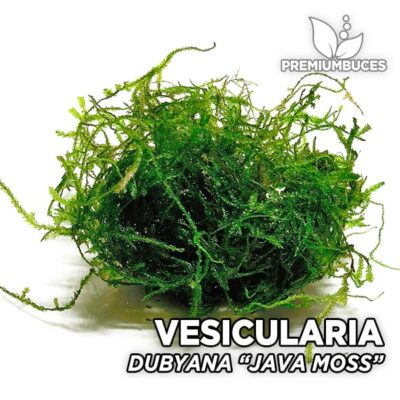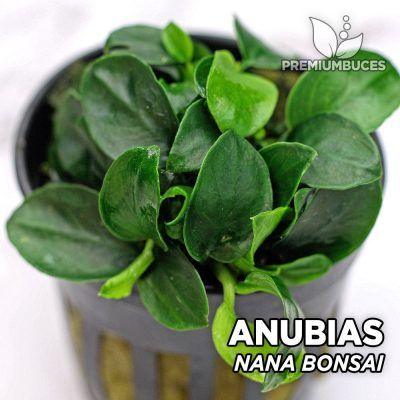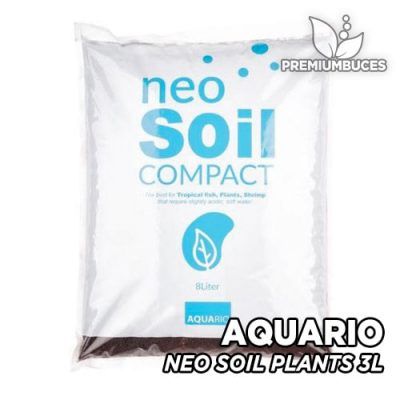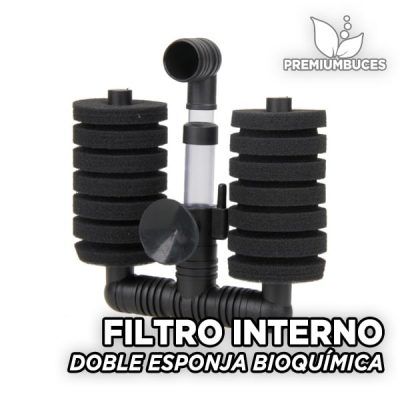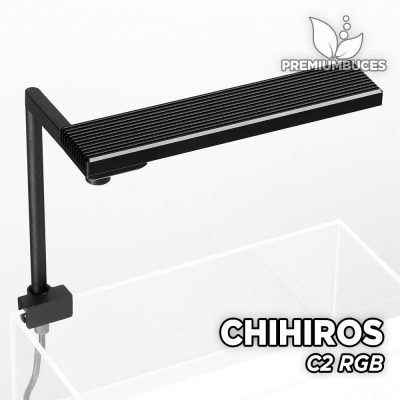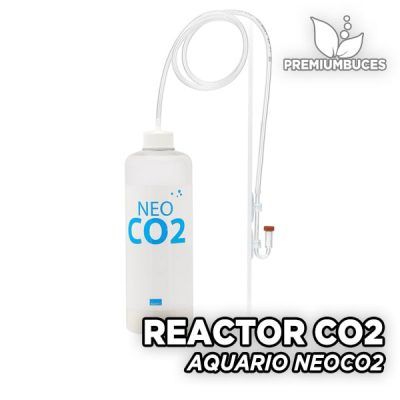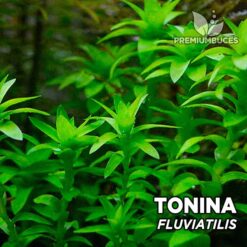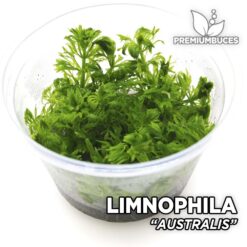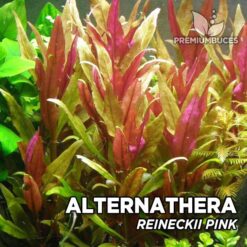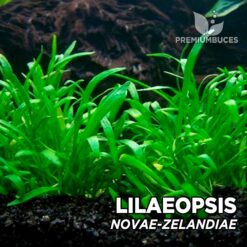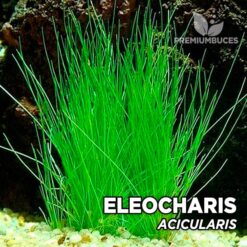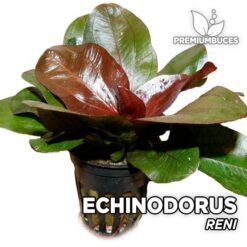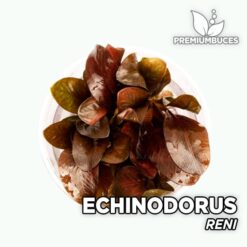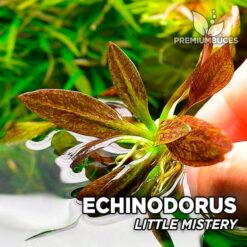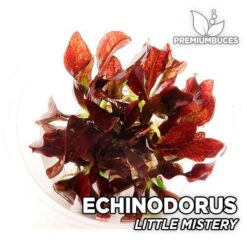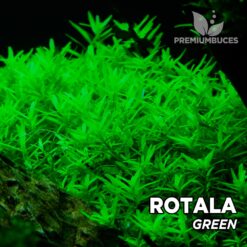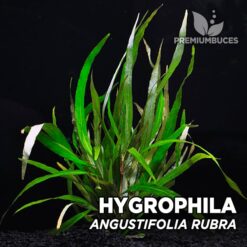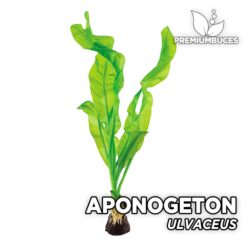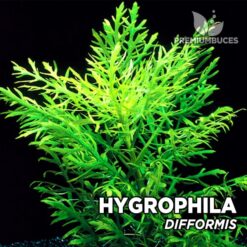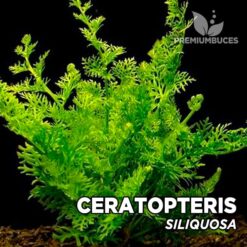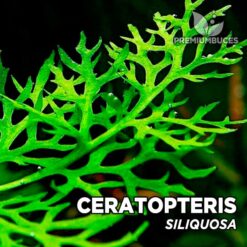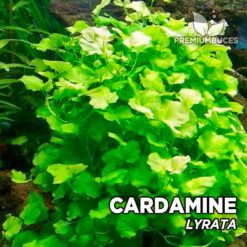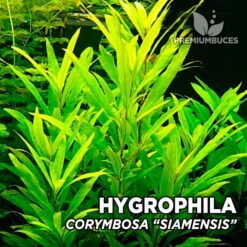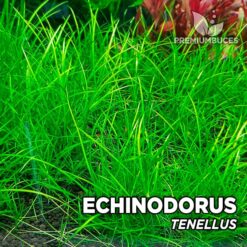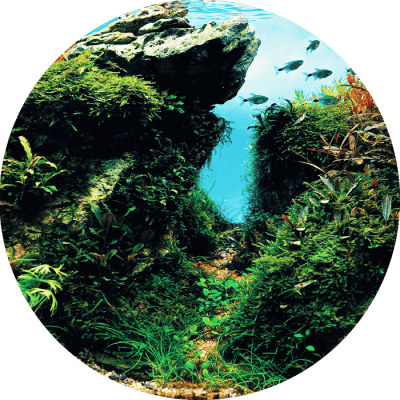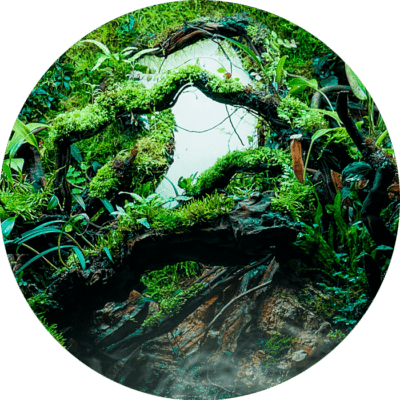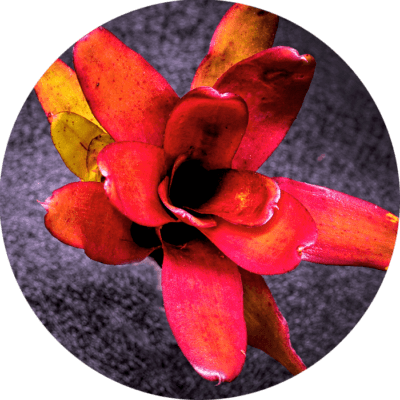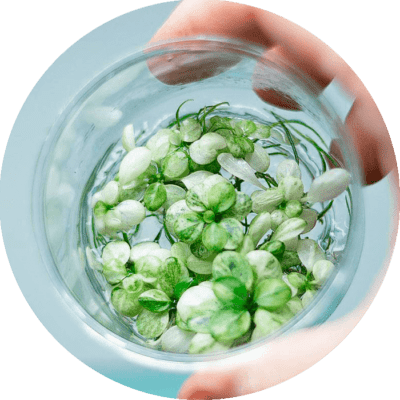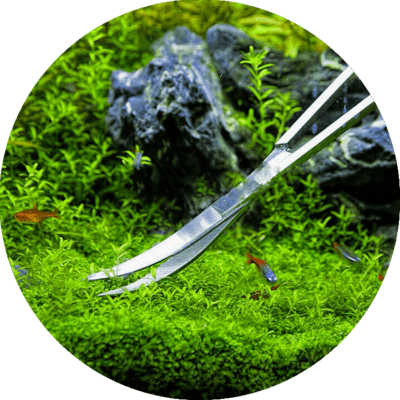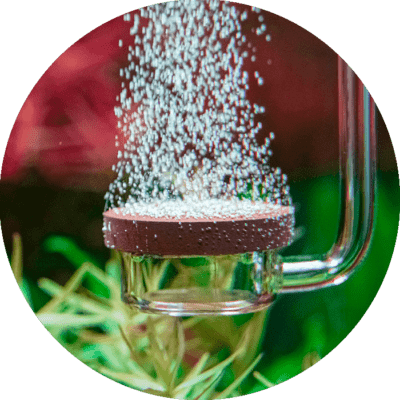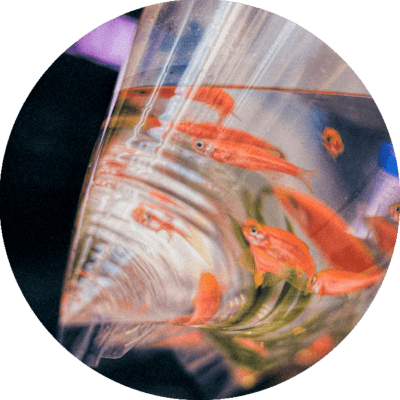It is likely that if you read this article from our blog it is because you are starting with an aquarium and you want to take it to the next level. We all have in mind those images of the more elaborate and curious aquariums and, although it seems that this hobby is reserved for a few, it is not. Let's talk about the basic principles of aquascaping so you can recreate these wonderful aquatic worlds in the home aquarium.
It is true that for this activity you need dedication and effort because you have to be aware of all the details. When we talk about aquascaping It is an aquarium assembly technique that has, apart from the common purposes of any aquarium, provide a particular aesthetic. The plants, rocks, wood and other types of elements are placed specifically to create a visually pleasing space.
HISTORY OF AQUASCAPING
Like many ancient practices, it is difficult to pinpoint its origin. However, most historians agree that the origin of what we know today as aquatic landscaping is located in ancient china. The large bowls of water found in this Asian country they keep fish of many colors and formations of flat marble.
According to records, it is known that the romans extracted these pieces of marble and glass to create some aquariums domestic to keep some barbel fish, which was a very appreciated species and symbolized for the family that owned it its great purchasing power.
The Complete Guide Freshwater Tropical Fish is a book that saw the light in 1970 and is edited by Raymond Legge. It is constituted as the first work generally written that gathers the basic principles of aquascaping. For many years, this was one of the great classics of those who thought of embarking on this path of aquatic landscaping.
Robert Warrington was an English chemist who credited with the first use of the term aquarius. As we have already seen, aquariums and captive fish farming are ancient practices, but there is a fundamental difference between a space filled with water and an aquarium in which they can live animals like fish.
To Warrington the first studies that attempt to systematize life in water are attributed to him. The fundamentals of life in the water are found in the oxygen and carbon dioxide cycle, this analysis has made it possible to know precisely what quality the water has where the fish live in their natural ecosystem. After various experiments, the aquarium turned into a habitable place for fish. Over time the contributions of plants and their regulatory action were discovered on carbon dioxide and oxygen.
From 1960 there are records on the first tests of use of a CO2 fertilizer in an aquarium. Magazine Tropical Fish Hobbyist published some studies where the uses of this supplement are synthesized. The articles were written according to the investigations and tests that were carried out in the Copenhagen Aquarium Club in Denmark. In this case, fertilization was done through the yeast method.
After a while, already in 1971, a German initiative by HILENA (subsequently DOUBLE), demonstrated the efficiency of using this gas in pressurized form.
En 1978 el Dr. J. D. Van Ramsh edit the book The Complete Aquarium Encyclopedia which refers to various aspects of aquarium care, above all, to what refers to the pressurized CO2: how it is used, in what cases and its benefits for the health of all the inhabitants of the aquarium. It is also talked about the dangers of its failure because, among other things, plants cannot carry out their vital processes well.
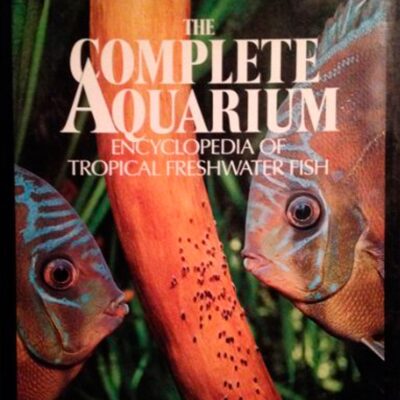
BASIC PRINCIPLES OF AQUASCAPING
- Imagination: One of the fundamental pillars to understand aquatic landscaping is to be able to let our imagination run wild. Capture our personality and preferences at the aquarium is one of the most fun parts. However, there are some guidelines to keep in mind to create a harmonious space. The great source of inspiration is natureIn the end, this style tries to recreate the natural environments in the water.
- Simplicity: Here you should pay close attention to understand that more is less. It is not necessary to place all the possible plants, nor all the decorative elements to create a visually rich space. Besides, this compromises the water quality in which the fish live and we must not forget that This is a place where beings with specific requirements will coexist.. The composition must be a perfect balance between simplicity and the particular imagination of each one.
- Proportion: The proportion is one of the great rules of this type of aquarium. The ancient Greeks defined beauty as the proportion of the parts to the whole. It doesn't matter if you want a densely populated garden or a more open space. Plants with large leaves do not usually work well because their growth is very fast and it is easy for them to break with the entire composition.
- Persistence: In these cases, we must be realistic and know that we must have the virtue of patience and persistence in keeping an aquarium. The amount of time and effort that these aquariums require is greater than any other space inhabited by other types of life. It is also possible that you have to change certain things if some complications arise.
DUTCH AQUARIUM
This is one of the most famous styles because his aesthetics have gone around the world. It is a type of aquatic landscaping that dates from the XNUMXth century in the Netherlands. From the focal point are emanating neat rows of plants that complement each other lower floors in the front y bigger plants in the background to create a space with different dimensions.
dutch aquariums they are generally more colorful and lively than other styles. They look a lot like a garden with a lot of care and dedication where plants are arranged in a specific place and according to a certain order so that they all have a place. None should be hidden because all plants have their function.
Not the most natural looking, but it is very pretty and stands out among all the other styles. It usually doesn't have too many elements other than plants because these provide a lot of texture, contrast and beauty.
The secret of style from the dutch aquarium is the use of many different plants. They are usually between 10 and 12 species the ones that are used The ones that are larger and leafier ones are in the back so as not to cover the smaller ones. In the background, it is best not to vary too much between textures and colors, the variety can be left for the middle plane.
You take into account the rate of growth so that they are all more or less homogeneous because when some grow faster than others they tend to break the symmetry. In the middle plane are important textures and colors to create more dimension. Try to create an organic contrast, remember that in the water there are different plants that share the same space.
The plants they should be arranged according to their kind so that there is a contrast between all of them. Although it is good to maintain an even space, it is also it is ideal to play a little with the sizes to make the space more dynamic. To make them look bigger and more abundant, you have to do sanitation pruning from time to time.
These are aquariums that do much use of aquatic plants, so it is unlikely that they will develop algae in the first stage. Another important point for a Dutch-style planted aquarium is know which fish are best for these cases. The gregarious fish they are the best option because with all the aesthetics of the plants it is enough, for which a smooth and uniform movement is needed, the same as that provided by this type of fish that usually swims together. Most of the species of the tetra fish they are a good option.

JAPANESE STYLE AQUARIUM
about three decades ago, Takashi Amano became one of the main drivers Japanese style or iwagumi. Is very popular with aquarium lovers and most of those who start with this hobby want to achieve an aesthetic like this.
This is a minimalist style what do you want to achieve more with less. Is part of japanese culture and has spread around the world. To express the beauty of this aquarium, one must be inspired by the peaceful and stable movements of the ocean. maybe it's the more difficult to make but, in turn, it is one of the most beautiful. This is because its configuration is very specific thanks to its natural and simple beauty.
The rocks are the most important part for these aquariums and plants remain only as a complement. Each rock has a particular function and together they create the composition. It is not an easy task, but it can be done.
The best thing is to take rocks with the same texture and with common patterns. However, the rocks should not be of the same size, on the contrary, They must be very different sizes. to create an organized hierarchy. The best thing is that he number of rocks is odd since, otherwise, it may seem somewhat strange in a style where great care is taken symmetry. The truth is that the placement is what will create a visual balance of the whole.
Colors also take place, but They must all be the same color and without too drastic variations. The oyaishi is the largest and its placement should be slightly inclined to recreate the movement of the sea. In order for this movement to be more uniform and real, it is necessary to place the inclination in the same direction that the water moves. The stones Fukunishi, Seishi and Suteishi they are also part of the space and should be placed according to their size in the aquarium.
The plants you have to choose them carefully because the focal point is the rocks. It is important that the plants do not cover the space of the rocks and that serve as a support to the landscape. As well you have to choose them according to your needs of carbon dioxide and sunlight. In these cases it will be a good idea to look for plants that do not have very high care requirements.
Although the stones play a fundamental role, in an aquarium with fish, they cannot be left without attention. Those who act individually can break the unity of space a bit. Those who act fit gregarious and kept in community are much more suitable. By Amano, this choice of fish continues with the general idea of an aquarium and this also serves to reflect the beauty of life, in contrast to the time that does not pass through the rocks. All the Tetras, Rummy and Harlequin Rasboras are the most common.

BIOTOPE AQUARIUMS
this is an aquarium particularly different because it has serious demands. Here it is about bringing a part of a natural environment home. In this sense, both species such as parameters, weather and fluctuations that can occur in a natural ecosystem, should be recreated in a small space at home. biotopes can be aquatic or semi-aquatic and this will depend a lot on the season of the year in which you are located.
In general, these spaces share very few species because maintaining an environment 100% identical to the one in nature is difficult and if it has to be multiplied by several animals, everything gets complicated.
The tannins are organic materials that begin to decompose and give it that dark color when it comes to freshwater formations. This part is important and we are going to have to drop some leaves to produce this chemical response. You may be tempted to clean the water, but the truth is that this does not happen in nature, so it is necessary let natural factors do the work. This is exactly the most difficult part of setting up a biotope aquarium.
When choosing fish and other animals you have to keep in mind that you must investigate the conditions of the water in great detail. When it comes to a first aquarium, you have to choose freshwater ecosystems because they are more manageable than marine ones, although cichlid fish or those with conflicting behavior should be avoided.
Generally, these types of aquariums are great because a natural space must be created and each element subtracts water capacity, so there must be enough space for the water to maintain the identical parameters as those in nature.
when you choose decorations or plants you have to keep in mind that you are do not affect the quality of the water too muchespecially its hardness. The separate spaces are important because create different places where territorial fish can live peacefully. Shelters are also important for shy fish like dwarf cichlids.
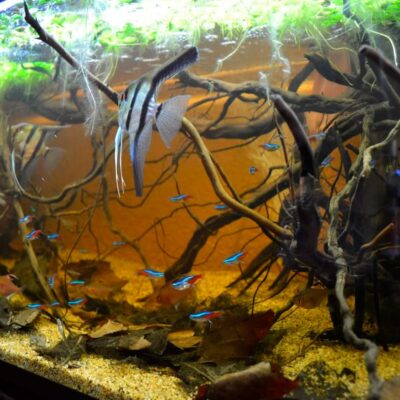
ASSEMBLY TECHNIQUES FOR AQUASCAPING
Many people believe that aquascaping is only for those who want very large and dense aquariums. Aquariums depend on the needs of the fish and the likes of the keeper. Some fish are particularly sensitive to stress, so you can opt for simpler spaces.
Keep in mind that each inhabitant of the aquarium needs specific care. The plants must be fertilized according to their needs, pruning are also important for prevent bacteria and disease. The leaves that fall to the bottom generate tannins that must also be cleaned and kept under control because they can become bacterial colonies, but when it is a biotope aquarium, it is necessary to know what amount of tannins is necessary.
The most aquariums big and bulky also require effort bigger economic. It is possible that you require several products to meet the needs of each one. You should also know that plants and other elements reduce the capacity of water and as soon as the population density in the aquarium increases, it will be necessary to buy a larger aquarium.
It is important ditch the artificial decorations. Aquariums are chemical ecosystems that are able to react when in contact with certain minerals. Certain aquarium toys are made of lead, which begins to decompose upon contact with water. Remember that fish in their natural ecosystems do not have "toys" to pass the time. If you like create a refuge space, you can make use of rocks and upholstery plants to make closed spaces where the fish can rest.
The maintenance of the largest and most voluminous aquariums requires regular water changes. Due to biological activity, potential toxic agents will grow. Even though you use a good filter, it is important to siphon the bottom of the aquarium to avoid agglomerations. The crystals can get dirty more easily when there is more activity in the aquarium and you may need to spend an average of 40 minutes a day in keeping a large aquarium.
Although the large, planted aquariums you see in stores may look great, the simplest and most minimalist options are a good alternative to have at home. Remember that aesthetics is a secondary element and any aquatic ecosystem must maintain the necessary living conditions for its inhabitants. the aquariums of low maintenance they can have one very attractive and careful aesthetics without having to invest as much effort and money as you would in a more complex model.
GET A BALANCE WITH THE ROCKS
All the live rocks are one of the best options for decorate your aquarium safely. It's one of the best bets because It's a way to fill the space without having to add too much visual information. Although it may not seem like it, rocks play a very important role in the aquarium. These are detached from the corals and become an opportunity for the proliferation of microorganisms which greatly benefit the chemical balance of the aquarium.
Not everything is about aesthetics and you have to create a balance between living elements that function as stabilizers of the general environment of the aquarium. Think that fish need a comfortable and beautiful home, for this you can use references of their natural ecosystems to recreate a bit of your natural space at home.
rock formations They are ideal for hiding. These places remind them of the natural waters where they were born. The more porous and deeper the holes in the rocks, the happier the fish will be, but keep in mind that these are more difficult for the caretaker to clean. Here you have to choose based on your routine because there is no way you can let bacteria get out of control on a rock through lack of care. When a long time passes, you are bacterial colonies end up becoming moss, fungi, or lichens And these do harm the quality of the water.
Note that calcareous or limestone stones should never be used to decorate aquariums. These end with raise the calcium carbonate level too high and make the water harder, that is, it has more salt, so it can be potentially deadly.
We are going to talk about an aspect that seems minor, but more than one person has this kind of problem in an aquarium. The rocks must be well placed and firm because with the movement of the water they can fall and cause any damage to the aquarium or equipment. It is also necessary to avoid that when moving or falling they damage any fish.
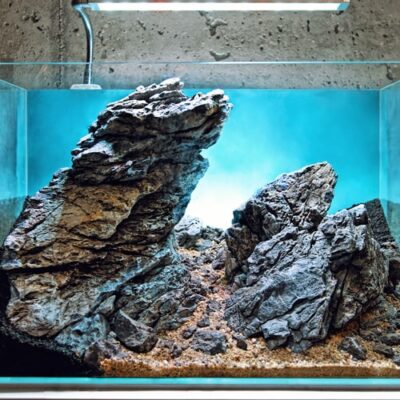
USE COMMON SENSE
Even if you are tempted to put in the aquarium any element that looks goodkeep in mind that there inside there are lives that can be affected for any incorporation. There are pet stores where they sell certain plastic artifacts which may seem interesting to fish, but be careful. You have to make sure that These objects are completely innocuous and do not affect life of fish and plants.
El varnish is an element that can decompose because the chemical characteristics of your aquarium can begin to degrade it. The components will begin to break down and dissolve in the water. Some parts may even remain in pieces large enough for the fish to absorb.
We have observed that some decorations have become very fashionable like treasure chests and divers, but the truth is that It is not recommended to place this type of elements in your aquarium. As usual they produce bubbles and although this does not affect the fish, it does affect the plants. These bubbles cause carbon dioxide to escape to the surface and this is the gas that plants use at night.
We must make another mention of sharp objects that can hurt the fins of the fish. Although these artificial decorations may look attractive and entertaining for your fish, the truth is that they don't need them. when these animals They are in the sea or in the rivers, they have none of this and it is important to know that fish are a particular type of pet and do not function like dogs or cats that can have a more active and dynamic life. with what proportions a healthy and calm environment for fish, it will be more than enough.
CREATE AN AQUARIUM WITH YOUR OWN CREATIVITY AND IMAGINATION
Although decorating an aquarium is a very exciting taskYou have to keep several things in mind. You have to plan thinking about the space and needs of the aquarium. The best rule in these cases is start small and gradually increase the difficulty as you gain more experience and skill.
Note that the number of elements in your aquarium strictly depends on the space you have available. It is good that you use your imagination and creativity for this task. Try to walk away and look at the aquarium from a distance. to get a more complete idea. The most important element is the fish and if these are lost among so many elements it can give an appearance of disorder and chaos.
Imagination has to go hand in hand with order and symmetry. It is good to create a kind of sketch so that you can have a clearer idea and correct any mistakes before going to the aquarium. Think about the style you want to give to the aquarium and how you want it to look in the room.
Remember that any element that enters the aquarium must be fully disinfected, and if necessary use a quarantine Aquarium, it's much better. If it's an aquarium just starting the hydrogen cycle, you should include everything except the fish and plants from the start.
Something that many do not take into account, but is very important is that fish inherit behaviors from wildlife. Most animals in the aquatic world know that are likely to become prey for other larger fish. Over time, learn to develop camouflage skills and remains alert to its predators. In this sense, a decorated aquarium and with various elements it will make them feel much more comfortable because they will not be so exposed and observed.
We highly recommend the use of aquarium backgrounds because they have a function very interesting aesthetic and do not affect the life of fish. Is about a vinyl that is placed on the back wall of the aquarium to make the colors look more vibrant and intense. They are also very useful for create contrasts and separate spaces. If you want a feeling of greater breadth and depth, this is a great option. A great enemy decorative aquariums not placing the plants well.
Use them colors and textures of plants for create more dynamic and interesting spaces. Although it may seem obvious, we are not going to fail to mention that taller plants should be placed on the sides and in the background so they don't hide the others. Furthermore, this organization gives more structure to the space. When there is a juxtaposition in the placement of the plants, chances are it will all look very messy and pointless.
Remember Plants are living beings that need care. in various ways. As easy to care for as they are, it doesn't mean they should be left to their own devices. If they don't have what they need, chances are they other types of plants appear much less aesthetic and unwanted like algae.
A common but very effective idea is use plants and decorative items to cover aquarium equipment. The heaters, filter and other types of equipment they break a little with the naturalness of the space, but it can always be solved. Even if you use a lot of decorations and plants, try not to vary too much in the types of these so that it does not seem like a place where there is everything but that does not look coherent and synchronous.
Finally, remember that the aquarium also It must go in tune with the room in your house. The aquarium is a very interesting element to function as decorative focal point in a space. They give an air of naturalness and are very attractive. In the end it's your aquarium and it's going to be in your house, so always play with your tastes to decorate itOf course, without neglecting the health of the aquarium in general.
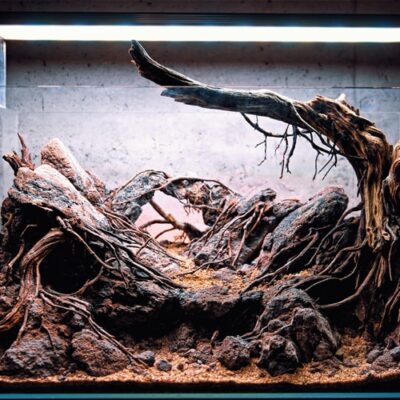
CHOOSE A FOCAL POINT IN THE AQUARIUM
Aquariums are more multifaceted than we usually believe. Mostly, should be a suitable place for fish, but after this we can put our decorating skills into play. As in any case, you have to structure the decoration and one of the great ways to orient everything is to use a focal point to become the center in which everything revolves around.
One of the key points for a proper and harmonious aquascaping is know how to guide the viewer's gaze to where you want. Think about what interests you the most and what we consider to be the most attractive in the entire space. You can imagine the focal point as the place that will receive the first visual impact and also the one that will guide the way of looks towards the secondary elements, but which are just as important.
Take into account the size of the aquarium because it is essential to maintain symmetry. If you have a small or medium aquarium, it is best to choose only one focal point. You can use plants, rocks, logs or other natural elements. If you have a very large aquarium at home, such as the 400-liter specimens, it will be very difficult to choose just one focal point because it is very easy for it to get lost in the middle of all the space.
Remember that the type of focal point will depend on the style that you choose for the aquarium. in aquariums dutch guy or jungle, the best thing will be to choose a plant or set of plants. for aquariums style iwagumi, definitely, rocks are the best option. In other styles can be fish those who take the focus of all attention.
When we want an crowded aquarium, you probably have trouble establishing a focal point. The single point that steals your attention may not be well defined, but then you should play with proportion so that all the elements shine without overshadowing the others.
El Focal point you can also get it with colors, shapes, or texture. There are certain plants, such as Anubias Nana, that although they are very small, their leaves have a very particular shape and when they are planted together, a very interesting kind of shrub is formed. In the middle of a very green aquarium, you can incorporate a plant with a reddish or yellow hue to become the point of attention, not because of the size, but because of its color.
golden ratio
The ancient Greeks already tell us about the importance of proportion or golden number. Believe it or not, aquascaping takes several of these fundamental principles in which the proportion of 1:1 by 1:1.618 which is much more pleasing to the human eye.
Various structures that we find in nature and assimilate as very harmonious are snail shells, the veins of the leaves of some species of trees. The symmetric rules for sunflowers, for example, follow this same proportion.
Although this is a very good idea if you don't find a symmetry that manages to find the aesthetic you are looking for, there are always exceptions that look great. Aquariums that are shaped like an island and where the population density is in the center are very attractive if they are carried out in a good way.
To put it in simple words, to find a comprehensive and attractive proportion, You take the focal point out of the center of the space. if we are going to use a rock as a focal point, we tend to put it in the middle of the aquarium, but this makes the eyes wander all over the space without any order. Instead, when the focal point is slightly tilted to one side, this makes viewers explore the space more closely and carefully. It is important that, as a counterbalance, the smaller elements find themselves with more presence on the other side.
It is possible that up to now you have no idea how to carry out your aquarium in a practical way, but we are going to it so that you have a clearer understanding of what we are talking about.
- Firstly, measure the whole length from one end to the other with a ruler or tape measure.
- On a calculator, divide this result by 2.618
- From one end of the aquarium (it doesn't matter which one) measures the result of the previous operation and it is exactly in that place where the focal point will go. For example, if you have an aquarium with a total length of 120cm/2.618 = 45.83cm from the far right or far left, that doesn't really matter, measures up to 45.83 cm and that is the place of the focal point according to the rule that we mentioned before.
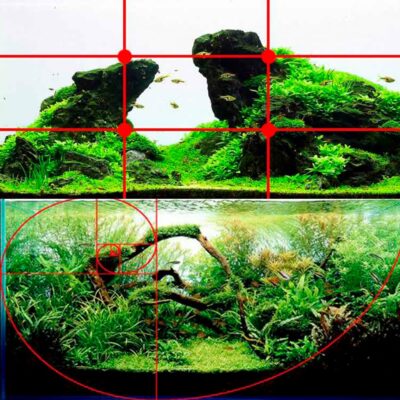
RULE OF THIRDS
The famous rule of thirds It is one of the best known in the world of aquascaping. It's another way of placing the pieces in the aquarium and if you know a little about photography, this rule may sound a little familiar to you. This time you have to divide the entire aquarium into 9 rectangular sections with the same measurements. Is about 2 imaginary lines horizontally and other two upright. After this they will stay 4 points where the lines intersect and they are called strengths.
These points are important to guide us. The most important elements and for those who want the aquarium to stand out, you must place them in these points. It does not matter if it is one or more because the important thing is that all these elements are going to create a kind of center where the gaze of the observer is going to be enclosed and will find some symmetry because the objects are placed at a certain height and at a parallel distance with respect to the others.
It is important that play with the elements so that these do not compete with each other. It is a good idea to place a rock or more important piece in one of the points and the others, which play a secondary role in space, in the rest of the points.
This is the option we most recommend for those who are starting with these topics that may seem a bit complicated at first. This rule of thirds is the one demonstrates greater symmetry and more pleasing to the human eye.
PLAY WITH THE PLANS
You may not have realized it, but in an aquarium there are many more dimensions than you think. There 3 plans those that are normally talked about and it is important to be able to differentiate them to make a harmonious composition.
The best guide is divide the aquarium into sections so you don't feel lost in front of such a big space. If you have small spaces for decorate independently, its alot easier take on this task. As aquariums attempt to recreate environments found in nature, it is important to take into account the depth of space.
Foreground: This is the part that is closer to the front glass of the aquarium. It is an important space because is the most exposed and the looks usually go directly to this area. It is good to place in this space plants, trunks and rocks of low height, but with great showiness so they don't get lost in space. The upholstery plants and anubias nanas they can work very well to give a dynamic look to the foreground.
medium plane: In the middle zone you can include objects that are larger than those in the foreground, but you have to take into account that the decorations should be in accordance with the size of the aquarium. If you have a small space, you should not include any element that is too large because it will look out of place. The stones They are a great decoration for this space.
All the stones horizontally are a great idea because it is a simple element, but capable of attracting attention. This is usually the ideal space to place the point or items. aquarium focal points. you can put some smaller stones so that everything is more homogeneous and natural because in the rivers or in the sea rocks are not isolated.
third plane: All the bigger and showier plants should enter at this point because elsewhere they can overshadow and interrupt the continuity of the aquarium. Some hobbyists enjoy creating a certain vegetal wall throughout the rear glass, something like a background that hide the glass and gives the impression of being in a natural environment.
In this, it must be borne in mind that some styles, such as iwagumi, third plane is left totally empty so as not to overshadow the rocks of the middle plane. This also it's a good optionespecially if you have a small space because keeping the background without anything will allow the view to have a longer and deeper journey in the aquarium.
An idea that has been gaining strength in recent years is create several planes in the middle of the whole space, in other words, smaller planes next to larger ones to make everything look more fun. The shrub-like plants They are very good because they also grow vertically and are able to fill the space well.
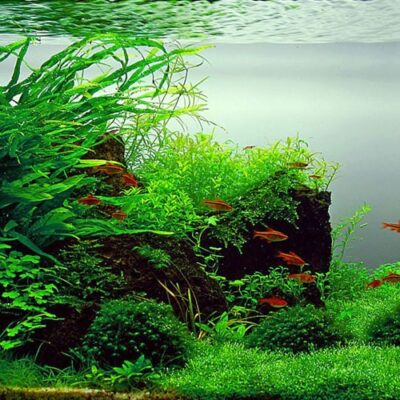
THE SYMMETRY GAME
Although symmetry is important, there are ways to break it without creating chaos and disorder in the aquarium. Although you may think that in a symmetrical aesthetic everything has to maintain the same order, size and style, the truth is that it is not symmetrical, but monotonous, and this is the last thing we want for an aquarium. Think about the face of any person, if you were to find flat and unchanged features, it is likely that you would seems very boring. Similarly, aquariums should maintain a dynamic symmetry in which they can distinguish colors, sizes and textures. In fact, by the water movement, is very unsightly that everything else remains stationary, inert and lifeless in the face of the movement and audacity of the water.
Try to search elements with different sizes so that the observer's eyes have to change position and find the typical movement of water. In the water there are many species of different sizes and with different aspects, so you can take inspiration from these images to bring it to your own aquarium. However, do not stop capturing your personality and character in your aquarium.
THE IMPORTANCE OF PLANTS IN AQUARIUMS
All the Facilities They are not just a decorative element, but are a vital element for maintain biochemical balance from the aquarium. They are the best way to manage nitrates because provide additional oxygenation, which helps create a much healthier environment for fish. They are also usually a refuge very important, complementary food and they can be one of the best places for spawning and holding fry during his early days.
There are many kinds of plants aquarium but you must choose the ones that complement each other. Remember that like all living things, plants need certain conditions to be able to live. Some plants may require more care than others, so you must take into account the time and dedication that you can give to the aquarium. Certain plant species can be very attractive, but also difficult to care for, so we recommend that you be realistic and think of plants as living things just like the fish.
VESICULARIA DUBYANA OR JAVA MOSS
This type of moss Belongs to the Vesicular family and it is one of the most popular options because it is fairly easy to care for. Often used as upholstery plant and is capable of growing on many aquarium surfaces. Can plant it on rocks, logs or gravel to create a more natural look where the moss appears to be growing out of the ground as it usually does on your natural ecosystem.
It is not necessary to plant it because its roots are of the rhizoid type that they can grow anywhere without the need to bury its rhizome. The smallest fish will be very grateful for this moss because in it can take refuge while they grow up.
his appearance is very dense and populated. They have a lot filaments with an elongated shape so it looks like some kind of spider. Usually this moss has a green standard but it is possible to find some specimens with lighter or darker tones, there are even some mosses that have certain transparent areas. Although it has a slow growth es very resistant, you may also have difficulty acclimating, but once the adjustment time has passed, usually grows without any problem.
El Java Moss is original of the southeast areas Asian and usually grows in lagoons, lakes and streams. In the aquarium must have the following conditions:
- El temperature range should be kept between 20ºC and 28ºC.
- La hardness should be between 10gh and 12gh.
- pH between the 6.5 and 8.
La lighting who needs a moss should be tenuous but it can also grow with any type of lighting, although if it is at the extremes of little or a lot of lighting, may have growth problems. It must also be taken into account that the seaweed They proliferate more in an aquarium with a lot of light.
Buy JAVA BARBIERI MOSSAnubias
If you have been in the world of aquascaping for some time or are just starting out, you probably know the Anubias. They are very popular because their care is very easy and they look great in the aquarium. On crecimiento it is one of the slowest so no need to prune too often its leaves.
There are many varieties de Anubias, but most usually have a very intense green color in their leaves and are very disease resistant. It easily adapt to the parameters of the water and do not tend to grow too much, so it is ideal to place them in the front of the aquarium.
They are part of the family of Araceae and originate from Tropical africa in places like Senegal, Angola and Zaire. They grow in the river banks and some of its species are semi-aquatic.
- La temperature must be between 22 ºC and 28 ºC.
- pH de 5.5 and 8
All the Anubias They can live in very soft or slightly harder water.
The requirements of lighting are not very demanding, But Anubias They usually feel comfortable when the lighting is dim. This is because in his natural habitat they live at shade of trees.
Buy ANUBIAS NANA BONSAIBUCEPHALANDRA
La Bucephalandra is an aquatic plant rhizome family Araceae found in rivers with rapid currents, very similar to those Anubias y Cryptocorynes. When they were first introduced to the aquarium hobby, they were compared to species of Cryptocoryne for his appearance in general. However, its rhizomes and roots are more in line with the characteristics of Anubias.
These types of plants They have known each other for more than 150 years. but it's not that long since they were introduced to the planted aquarium hobby. The gender Bucephalandra It is a plant still relatively difficult to find in stores that captivates many fans around the world thanks to the attractive appearance of its leaves and striking colors.
These aquatic plants They are from the island of Borneo. To this day, they are continually discovered new varieties of Bucephalandra that had not been previously scientifically recorded.
La Bucephalandra is in rivers and streams, usually on the banks of rivers. Borneo has a tropical climate, which means that it is not the same climate all year round, with average annual temperatures above 20 degrees centigrade.
Buy BUCEPHALANDRA SOLID BLUECRYPTOCORYNE
These are plants that come to be known as water trumpet and it is a very broad genre that includes 69 different species. Most are aquatic plants part of the family of Araceae. Naturally it extends through the towns of Sri Lanka to New Guinea, including the territories of India and China.
It is very common to find them in many aquariums largely due to their colors, textures and sizes. We recommend them for those who do not have so much experience in plant care because they are not very demanding. some specimens they have colors that go from yellow tones but also brown colors. Their leaves can be straight, wavy or spiral shaped.
Some species of C.ryptocoryne can grow out of water and prefer an enriched aquarium. You can also choose between the siltiest and lightest substrates such as gravel or fine-grained sand.
Although some of these plants can be very easy to care for, some others are very complicated and they are a real challenge even for the most professional. It is not necessary include a extra CO2 supply and you should not choose a very specific lighting either. He water aquarium it has to be changed very often for maintain hardness general.
- El pH must be between 6.8 and 7.8
- La general hardness must be between 8 and 10
- La temperature must be between 23 ºC and 26 ºC
HOW TO CHOOSE THE SUBSTRATE FOR THE AQUARIUM?
Know if the aquarium will it have a substrate or not and what type to choose It is one of the first decisions to be made. If you have been caring for an aquarium for a while you will already know what to do but you may be a bit puzzled if you don't know what this is. Many people think that it is a bit complicated to maintain a substrate because it must be cleaned to prevent it from becoming a nest for bacteria that can be converted into nitrites.
El substratum It is that area that is at the bottom of the aquarium and can be sand, gravel or some other organic material. The substrate has a more than decorative function y helps for nitrogen cycle bacteria to develop.
For some it is just a source of problems because dirt accumulates in it. Actually, are an important part of the development of an aquatic ecosystem. Also, if you have plants in your aquarium, it is a very important part so that they can be nourished.
In particular, we highly recommend its use because it is a source of important nutrients and, if it is kept in good condition, there will be no major problems. Also you must take into account the type of fish that you are going to choose because, for example, burrowing fish need a certain type of substrate.
SUBSTRATE TYPES
If you go to a fish store, you will find a very high diversity of substrates. However, we are going to divide them into 3 large groups so you can have a clearer idea: the nutritious, inert and clayey.
INERT SUBSTRATES
These models are Built mainly of gravel and sand. It can be found in a lots of colors and size for each type of aquarium. As to aesthetic optionsThis is the most varied option.
If you are going to choose a inert substrate with color, no problem, but you have to take into account that you must avoid the artificially colored options. In general, this type of dyes have toxic agents They are released into the water and can be taken up by fish.
They have no impact on the chemical balance of the water. does not change the quality of this and is one of its main attractions because it's easier to control. However, not everything is good and one of its main difficulties is that you can't plant on it because it is very difficult on this type of substrate.
When the inert substrates are sand, the thickness is usually 0.5 to 2 millimeters thick. This is one way of measuring and is known as granulometry and you can find sizes thicker or finer.
Maybe the sand struggles in the long run because tends to compactWhich can complicate the water and air cycle, a situation that would give rise to the anaerobic bacteria. On the other hand, the sand is very decorative and can combine with other items such as plants, gravel, rocks or logs. It gives a great feeling of a natural and unique aquarium.
Se can use as plugin placing it in a certain way in some areas of the aquarium. It is ideal to give greater altitude and dynamism to the aquarium. What differentiates sand and gravel is the size because gravel has a granulometry which is between the 2 and 5 mm.
The larger size of the gravel makes it easier for water and air to flowWhich is ideal for oxygen exchange so that toxins that harm the aquarium ecosystem do not appear. Although inert substrates do not influence water quality, you can combine them with other types of nutritious substrates.
CLAY SUBSTRATES
Many times, clay substrates They are considered as inert but, the truth, it is not like that. They have the ability to change the parameters of the water and that is why we are going to talk about this type of substrate in a little more detail.
The nutrients that has the clay are iron, aluminum oxide and magnesium. These nutrients they are releasing for a fairly long period of time.
Another capacity of these substrates and that most do not know is that are able to exchange ions. They have one high amount of negative particles that attract positive particles such as those found in the calcium or magnesium. This helps a lot so that these nutrients are more easily absorbed by the roots of plants.
Es rare to see it as a substrate in most aquariums but yes often used as a complement or in the company of other types of substrates. Which Not recommended is to be used as a covering substrate because it has dust particles. For this, the water becomes quite cloudy for a long time.
This type of substrate it helps a lot if you have problems with the water parameters. Is able to lower the ph level and also overall hardness. It is also ideal for help oxygen circulate more easily. It is one of the best options for plants to establish themselves strongly and helps much in the improvement of the biological environment because serves as a biological filter.
The large problem of this type of substrate when it is in direct contact with water is that when it moves raises a lot of dust. If you are not clear about the decision between choosing inert or nutritious substrates, this can be an intermediate option that is very beneficial. You should treat it with the same caution which should be taken with the nutritive substrates but does not have such an impact on the quality of the water. If you are a beginner in this world we recommend other types of substrates They are much easier to care for.
NUTRITIVE SUBSTRATES
These are the ones that do have the ability to modify the water parameters such as the pH, gH and KH because have a lot of organic matter which is the source of nutrients for plants. They not only have organic matter, but also contain clay.
If you are going to use this type of substrate, it is best that it be place a layer of gravel on top of this. In the case that you want the plants to be in direct contact with the nutrients it is ideal to put some gravel under this substrate.
When buying the substrate, It is best to ask and find out in the store on the type of nutrients and how it could affect each of the parameters, especially the most influential ones such as pH. This should be taken into account because water and its parameters are the most important thing What's in an aquarium? From his quality, the life of the plants, fish and other living elements that are in the aquarium will depend.
La structure of the substrates can vary quite a lot from one model to another. These substrates are designed to be in contact with water and not move too much with biological activity. The organic matter will be released little by little for long periods of time.
La granulometry It can vary a lot from one model to another because some are intended to be used alone, while others must be used in company, made of gravel, sand or clay. Those that are designed to be used in solitaire they are very pretty and look very good because they have dark colors like the brown and black.
Some enriched nutrient substrates They have a specific technology for preserve water parameters under specific conditions. It is used for certain plants and fish be comfortable and healthy.
When nutrients do not have enough plants to absorb them, these begin to break down and turn into nitrates and toxic substances.
If you want a substrate of long duration and that maintains the amount of nutrients in good condition for plants, it will be best to choose a soil type substrate. The great problem of this type of substrates, is that they are quite specific and we recommend it for caregivers with some experience and who are familiar with the performance of nutrients on water quality and parameters.
Because these substrates have large amount of nutrients, the best is combine them with inert substrates. The amount of soil type substrate would be high, from a thickness from 2.5 to 4 centimeters to finish covering it with a layer of fine gravel or inert substrate.
Another of the great benefits of the soil-type substrate is that They are very good at contributing a little more CO2. This release is gradual and slow. Note that this substrate releases nutrients in large quantities during the first week. This is a dangerous situation for fish.
Buy AQUARIUM NEO SOIL PLANTSTIPS FOR CHOOSING A GOOD SUBSTRATE
- If you are starting and do not know the technical and chemical specifications of the aquarium well, try to use other kind of inert substrate like gravel.
- Remember that the plants they must be able to feed on all these nutrients. It's good start with easy care plants. However, with time and experience, you can increase the difficulty and start to include more complex care plants.
- You can choose this type of substrate for certain areas of the aquarium so that a excess nutrients. For example, use this substrate only in the area where the roots of the plants are found.
- If you want to be a little more careful with this type of nutritious substrates, you can opt for substrates mixed with sand or gravel and decrease the amount of nutrients.
WHAT AMOUNT OF SUBSTRATE SHOULD BE USED IN THE AQUARIUM?
substrates they are not sold by the kilo, but by liters and you have to calculate the number of liters of substrate material in relation to the height you want to reach in the aquarium. Use them cubic centimeters and convert to liters and is the amount you need.
For example: aquariums 100 cm long X 50 cm wide and 5 cm substrate height = 25.000 cm3what are you going to divide by thousand and is the number of liters of substrate you need = 25 liters.
FILTERS FOR AN AQUASCAPING AQUARIUM
El filter is essential if we want to make our aquarium a healthy and semi autonomous ecosystem. In the vast majority of cases, keeping your aquarium without any filter is impossible because the fish and the plants will end up dying.
Many think that lighting and filters are the most important parts of your aquarium. However, you should keep in mind that there are many filters and there is no perfect filter, but you can choose the one that best suits the needs of your fish and plants.
The filters take care of clean the water of toxins, but it does not only work for this purpose. These teams also are able to retain other particles slightly bigger and stronger as parts of plants or detritus. This is important because these particles can become absorbed by the fish and get sick.
In rivers, filters work naturally and the water ends up being clean without any human intervention. The water circulation in a stable and systematic way helps a lot with oxygenation and, with this, to the cleanliness of the water. The filters are the first solution so that the residues of biological activity do not put the lives of the inhabitants at risk. Besides, They greatly help fish and aquatic flora to grow stronger.
HOW FILTERS ARE USED
The operation consists of take the aquarium water to reach a series of filter materials and after being free of dangerous agents thanks to the bacteria that degrade the toxins, the water returns to the aquarium. The most important part of this kit is the bomb because this is the one takes the water and transports it to the filters. It is also the part that is responsible for making the water travels through the hoses to the aquarium.
WHAT FUNCTION DO THE FILTERS HAVE?
If there is any important element to keep an aquarium, it is the filter. Its main function is free the water of impurities that may endanger the life of the aquarium inhabitants.
For example, standing water that is not moving can end up being very dangerous. It is normal for the water to deteriorate if it is not oxygenated and does not move but, in the natural ecosystems, this process is natural and the water stays clean. For this reason, in natural aquariums they need filters.
Also keep in mind fish waste, food scraps and biological activity of plants. These leftovers can get out of control very easily. These toxins break down at the bottom of the aquarium and end up infecting the water. in which the fish live. It is right here where the filter becomes a fundamental piece in home aquariums.
TYPES OF FILTERS
There are many filters and models. If you go to a store, you may get confused with the number of models, functionality and specifications, but let's divide them into two large groups (although they're not the only ones): internal and external filters. The external filters tend to be larger and bulkier so they are designed to work in very large aquariums. The internal filters are smaller and can be installed in the water but they are not usually as powerful, although they are sufficient for small spaces.
EXTERNAL FILTERS
These types of filters are placed outside the aquarium and can be kept hidden under furniture. The truth is that they have many advantages compared to other types of filters. Nowadays, have become one of the most popular options among aquarium keepers.
It works with pumps that they extract the water, filter it and send it back to the aquarium clean and oxygenated. In a removable glass of the filter is the filter material that cleans the water.
One of the things we like the most about this type of filter is that they have a much higher filtering capacity than the other models. You can change the filter material and, in this way, use the one you prefer according to the needs of the fish and the plants. They have a capacity and a quite autonomous operation and their maintenance and cleaning are quite easy.
Another of the very important benefits of some of these models is that they are pretty quiet. Many beginners do not take this into account but some filter models can be really annoying with the sounds they produce when they are in operation.
Something that is a great disadvantage is the price. It is true that they are usually more expensive but their benefits are worth it because they are quite efficient in their task of cleaning the water. Also they are easy to maintain and clean. On the other hand, you must think of a piece of furniture personalized enough to hide this equipment and that does not hinder the aesthetics of the aquarium.
Buy EXTERNAL FILTER BLAU FM-360INTERNAL FILTERS
As its name indicates, These are filters that are placed submerged and inside the aquarium. Today, you can find many different options and it works just as well as any other type of filter, including external ones. There is various benefits to keep a filter inside the aquarium.
All the sound waves penetrate the water much less so these filters they are much quieter and more discreet. In addition, they are very easy to use because they are designed for small aquariums and its operation does not require so many manual configurations. Something that can be a great advantage of these filters is that they are a little cheaper and it is a great option when you are starting with an aquarium and you must invest a lot in equipment.
When it comes to equipment that works in the water, you should keep in mind that these decrease the total capacity of the aquarium. You will also have to work a little harder to hide the filter with plants or rocks.
Buy DOUBLE SPONGE INTERNAL FILTERBACKPACK OR CASCADE FILTERS
These are pretty aesthetic aquarium filters because, when they are in the process of filtering the water, they put it back cleans into the aquarium like a waterfall. They are also known as backpack filters because is placed on one side Like I'm hanging like one of these. So, in any aquarium you have to take into account that there is no perfect filter, but you have to choose the one that best suits your needs.
One of the best advantages of these filters is that do not take up space, something very valuable if you do not have much space for the inhabitants of the aquarium. Visually they are quite imposing and attractive but it does not stay in this, but rather They are capable of filtering water with great power and they can work very well in aquariums of 300 liters or more.
Something interesting about these filters is that you can play a lot with the filter materials and they do not have major difficulties in their maintenance and their configuration is easy. Since not everything is good in any team, you should know that they are a bit noisy and that, if you are not able to camouflage it or find a beautiful model, can be unsightly.
Buy BACKPACK FILTER BLAU FM-120OTHER TYPES OF AQUARIUM FILTERS
Sponge filters: These are rather delicate filters and they do not usually cause accidents in the middle of their operation. You should keep in mind that filters are very powerful devices to clean the water. However, this can be tricky for shrimp and other smaller, more delicate fish.
these little animals can be sucked if the filter is very powerful. In this way, the filters use a sponge that has a high biological filtration capacity. This filter is connected to an air pump that allows it to circulate through the water thanks to the pores found in the sponge.
in the sponge, nests a colony of bacteria that are very beneficial for the proper functioning of the aquarium. This occurs because the water leaves the aerobic bacteria in the sponge and they are the ones in charge of neutralizing the ammonia to prevent this from affecting the fish. He sponge filter also is capable of retaining larger particles so that the water remains free of these as they can be absorbed by the fish. Sponges require a weekly maintenance and must be cleaned with water from the aquarium itself.
FILTRATION PROCESSES
There are several types of filtration processes. Although the filters work by cleaning the water, they need a filter material to work. It is a biological, mechanical or chemical material that works together, but in different stages. Without these types of materials, the water quality is not what the aquarium should have and life will begin to enter into crisis in those circumstances.
To a large degree, filtration occurs inside the filter because in one of its compartments there is a place for the filter material that is usually arranged in layers so that it is administered on a regular basis. You should know that the filter material does not work alone and you must choose a filter that is suitable for this type of material since both (filter and filter material) work as a team.
Keep in mind that without filter material there is no type of filtration and the water will return to the aquarium in the same way. On the other hand, if the filter material is not adequate or is of poor quality, the water will have poor quality For this reason, several considerations must be kept in mind.
MECHANICAL FILTRATION
La mechanical filtration It is the first stage of filtering and it is the simplest and most intuitive part. There is not much variety of materials and their function is the same in all cases: retain solid particles in the aquarium, from the largest to the smallest. In this case, it may be small pieces of leaves, leftover fish feed, animal waste and parts of the substrate.
filter material prevents solid waste from falling back into the aquarium. In terms of maintenance, the caretaker must clean this cavity for avoid accumulations that affect the operation of the aquarium and the recurrence will depend a lot on its biological activity. You must remove the waste when it begins to accumulate and for that you must look inside the filter to know when to clean it. In general, filter cleaning should be done once every six months, but this will depend on the type and power of the aquarium.
The filter materials they are usually the foamex and perlon wool. With a layer of each of these materials it will be more than enough for a home aquarium with plants. when you go shopping, try to choose a spongy and porous material with different levels of coarseness to retain different particle sizes. In general, the foamex must have a coarse pore to retain the largest particles. For its part, the perlon must have much smaller pores for finer particles.
El foamex must be the first layer that is in contact with the water, after this must go the perlon wool. It is not recommended to reverse the order of the filter material because many large particles can be strained and the filter will clog very quickly. Perlon is quite elastic and is capable of stretching to achieve a slightly thicker pore.
You don't need to change these materials too often because they are efficient enough to stay for a long time. If you are careful during maintenance, these layers can last many months without breaking when handled. To clean foamex and wool, it is only necessary to rinse with aquarium water, never with filter water.
If you have a very big aquarium which has a lot of biological activity and a large amount of coarse particles you can use other types of more efficient and resistant materials as time passed. Scouring pads or foam rubber are very effective filter materials in these cases.
BIOLOGICAL FILTRATION
After the mechanical stuff, there should be a biological filter material. It is a very important stage and largely determines the quality of the water and since its discovery it has become one of the great solutions for aquarium maintenance, especially for planted aquariums.
This part of the filtration is going to be responsible for harboring a number of very important bacteria for the aquarium. They are responsible for keeping ammonia and nitrites under control. They are something like the white blood cells of human beings that are responsible for fighting bacteria, infections and other very dangerous agents for fish and plants.
In general, the Biological filter material is ceramic or other material that has a similar number of pores. This pore thing is really important because if the surface is smooth, bacteria will have a very difficult time nesting.
Ceramic beads such as ceramic hollow cylinders with many pores, quartz spheres, and porous gravels are usually of the most common materials to carry out biological filtration. The famous bacteria of the water cycle nest in these materials, which is why it is very important that it be a very porous material so that fish and plants can have the environment they need to live.
It is possible to find another type of biological filter material for aquariums such as porous volcanic gravel and other similar but several precautions must be taken into account. Although in their function of filtering the water they are quite efficient, it must also be reckoned with can alter some parameters of the water.
If you are starting with an aquarium and you want to do your best, it is better to start only with ceramic beads or synthesized glass spheres and other types of inert materials. Although other types of materials also work well, it is better that you do not get involved with materials that can alter the parameters of the water since, yes, it is a very delicate matter.
CHEMICAL FILTRATION
This it is a kind of filtration a little particular but it is convenient to know if you want to maintain or change the parameters of the water. It's kind of chemical treatment of water to remove certain substances like medicines. This type of filtration is used in specific cases and for specific purposes. Here are some of those cases:
- Change the pH or the hardness of water.
- Eliminate toxic effects heavy materials like chlorine. This can reach the aquarium by the filter water and it is dangerous for fish.
- The drugs they can continue to cause effects in the fish after the treatment is completed.
- La green or yellow coloring It's a bit annoying in the aquarium and a chemical filtration it is ideal to remove this from the aquarium. This is because it is capable of retaining unicellular algae that have multiplied in the water.
- The dusty substrates can cause many problems during planting by removing the background. In these cases the materials chemical filters eliminate this amount of dust at the bottom of the water.
- The tannins are the chemicals that are released when leaves and other biological materials fall and decompose in the background. Chemical filtration can also be used for this problem.
It is important that chemical materials be placed after biological filtration. If they are placed before the big problem is that biological colonies will not have enough oxygen to thrive. These bacteria can go into shock from alterations in water parameters after chemical filtration.
Preferably and, to avoid problems and complications in the care of the aquarium, it is best that chemical filtration is the last because is the most aggressive. Although this It is a filtration that cleans the water very well, remember that it can damage the chemical balance of this if used too frequently and without need.
After 24 hours of filtration, it is time to that you consider suspending the filtration. After this time, the water will be free of medicines, metals and the cause of the leak will be eradicated.. After this time, the first affected will be the micro and macronutrients. These and other products to help plant growth they will be absorbed by the chemicals of this type of filtration. In addition, it will be a real waste of money and nutrients that remain inert against chemical filters.
This material It must not remain fixedly in the aquarium and must never be in the cycling process. because the bacteria necessary in this process will not proliferate. There are several chemical materials but the most popular is the activated carbonamong other things, because it is easy to get, cheap and works pretty well.
In this case you must wrap the activated carbon inside some textile material with very small pores. It is important that compact very well and hermetically so that even the most dangerous substances can be absorbed. After using a part, should be discarded and a new one used.
Although this is quite an option economical and functional, it is important not to go for the cheapest option because They can be of poor quality and end up damaging the aquarium water. These carbons can be found in various formats such as sponges or sieves soaked in activated carbon. Although these formats are very popular, we recommend that you lean towards granules and flakes of activated carbon because sponges and sieves don't work well.
ABSORBENT RESINS
All the resins are also an option used for chemical filtration. They are generally used for a filtering of specific materials such as phosphate, normally for prevent algae blooms. It is also used to attract calcium and magnesium ions and stabilize water hardness, especially when the hardness is very high.
Resins are also used for lower nitrogen levels. He ammonia, nitrites and nitrates can be absorbed by these resins. However, it is worth looking at if it is really necessary in planted aquariums. On the one hand, nitrates are important for plant development because work as a fertilizer. On the other hand, biological filters are often used to filter ammonia and nitrites. For all this, you must be careful to use it to the right extent and not overuse it.
Like all filter materials, must be removed from the filter to avoid poisoning or unevenness in the water parameters.
ACIDIFYING PEATS
As the name implies, these are peats that acidify the aquarium water. Due to the release of various substances, it is possible to lower the pH level to about 6 or 6.5. Among the acids with which the peat is impregnated, there are humic tannins that stain the water of a color similar to that which it has in nature due to the decomposition of biological materials.
LIGHTING FOR AQUASCAPING AQUARIUM
Lighting is very important in aquariums because health reasons and also for aesthetics. Remember that aquariums are ecosystems that are not only designed to be attractive to the eye, but also specific lighting is important so that life can prosper.
plants and fish they need light to live but it is not enough with any type of lighting, we must choose the correct lighting. It is important that you are clear about various lighting concepts such as the amount of light, type of lights and the correct way to make combinations.
You may be wondering about the amount of light an aquarium needs. As you already know, not all aquariums are the same, so you must know what type of aquarium you are setting up in order to provide it with the necessary light. The size and the species that live inside it will determine the type of light you need to use. We are going to give you a brief summary about the amount of light according to the type of aquarium:
- Exclusive fish aquariums: If only fish are going to live inside the aquarium, you have to reproduce the same type of illumination they have in nature. For this you must look at the light cycle and set the number of hours average per day that the fish receive that lighting dose. The number of hours of sunlight your fish get in the wild should be the same as it will get in the aquarium. When it is not produced in this way, it is very likely that the fish get stressed and have problems developmental. It is best that you use a Automatic system to turn lights on and off so you don't have to do it manually.
- Fish and plant aquariums: Aquatic plant species are very varied and there are a large number of different requirements. On the other hand, fish also have particular lighting needs. For this you must bring home specimens that have similar needs so that no one suffers excess or deficiency of light. Smaller plants usually need between 10 and 20 lumens for every liter of water. Some medium-sized plants need a little more light for their size (y entre 20 40 lumens is usually the average range). Larger plants need to exceed the 40 lumens of exposure for each liter of water.
Surely up to here you have already realized that there are many factors that influence the decision about the type and amount of light. You are going to need practice, knowledge and mastery of specific techniques. It is also necessary know the particular circumstances you have in the aquarium but there is nothing to worry about because with some time you will be able to master it without problem.
Many keepers believe that some lighting will suffice. Others think that the main objective is to illuminate the fish and that they have greater visibility. However, this is the natural consequence of healthy lighting, so as long as you have a correct lighting for fish, the whole aquarium will look great.
As it happens in nature, light always comes from above. For this it is important to place a number of lights on top. On the other hand, lighting the front of the aquarium is also important.
Buy CHIHIROS RGB VIVID MINILIGHTING YOUR AQUARIUM DURING THE DAY
Even if it is daytime, sunlight is not enough. Note that the light that enters any room is not as intense as the light that plants and fish receive when they are in the wild. During these hours you must have certain lamps that radiate light longitudinally.
To give you a general idea, fish that come from wooded areas or areas with a lot of shade from trees don't usually get much exposure to light. On the contrary, fish and plants in tropical waters or reefs do not have much shadow and the sunlight is usually very intense during the day.
LIGHTING DURING THE NIGHT
Believe it or not, some fish also need some lighting at night. In the night hours, the most common is that LED lights for aquariums are used. This option is much more efficient because it does not consume as much electricity as other options. Lots of fish, especially shy ones tend to be more active at night, so it is important to keep them illuminated so that they can carry out their activities.
Although there are some who prefer manual systems for aquarium lighting, the truth is that this can be very complicated. Fish are animals that like routine very much., so it is better and more practical use a timer that regulates light cycles without having to rely on caregiver settings.
TYPES OF LAMPS FOR AQUARIUMS
If you go to a fish store, it is very likely that you will see several options and you don't know which one to decide. This is normal, but we are going to make a brief summary so that you know what your aquarium needs.
LED SCREENS
If you want a lighting system, efficient and very aestheticyou will end up buying led light displays. They can be used in almost any case and illuminate the aquarium very well without leaving spaces of darkness. Also They adapt very well to both freshwater aquariums as to those of saltwater.
So, there are not too many rules regarding its installation. The truth is that there are many highly efficient lighting systems and each one with its strengths. Combining various types of lighting can allow both fish and plants to reap the full benefits of each type of lighting, so don't be afraid to mix and match. fluorescent, halogen and LED lights. Of course, you should always be well informed about the operation of each one to create a more general light system.
Buy CHIHIROS C2 RGBFLUORESCENT TUBES
Generally, They are the first options and we usually start with this type of tube because they are cheap and do not overheat the water ecosystem.. Some models have simple transformers and other specimens have a much more electronic system. As in any case, electronic models are more expensive.
These fluorescent tubes have different sizes, diameters and colors. When the aquariums are very deep or very large, there are light tubes that have a system that emits a lot of light to illuminate all areas. Marine aquariums often use a combination of fluorescent tubes with a bluish tint. so that the fish can feel some familiarity with the color of the deep sea.
METAL HALIDE LAMPS
When aquariums need lamps with very bright light radiation lamps are often used metal halide. The big problem with this type of lamps is that they are quite expensive although, on the other hand, they are really efficient. When installing you have to be careful because the natural grease found in the hands can damage its mechanism. During installation it is best not to touch the surfaces from which the light is emitted. Due to its price and its characteristics, they are usually recommended more for reef or marine aquariums.
THE LIGHT IN PLANTED AQUARIUMS
As we mentioned above, fish-only aquariums are a bit easier to manage because there aren't as many variants to look out for. On the other hand, when there are plants, the whole situation changes. Remember that the lighting has to be efficient for each inhabitant of the aquarium.
A common symptom of there is lighting problem in the aquarium is that the plants begin to take a darker, duller coloration. This happens because light is a very important factor for photosynthesis. When you are already facing this problem, there are two solutions that can save the plants.
- T5 and T8 type fluorescent tubes: This is one of the most common solutions and also one of the most efficient. They are able to replicate the quality of light that they have in nature quite well. To know the number of lights and their lumens, you have to take into account the watts that each tube emits. For example, if among all the tubes that you are going to install there is an amount of 0.56 watts for each liter of water, this is considered an average amount of light. In this case you must lower or increase the number of lights according to the needs of the aquarium.
- LED screens: This is the option that is giving the most war to traditional fluorescent tubes. They are very aesthetic, economical and are quite resistant to the use of time. This time, the light intensity is measured in lumens and an average lighting range is understood to be between 15 and 25 lumens per liter of water.
Everything we have mentioned above is indicative, so you should find out about the characteristics of the species that live in the aquarium. However, it is quite an efficient system when you are starting an aquarium for the first time.
Buy CHIHIROS RGB VIVID IIHOW MANY HOURS SHOULD I KEEP THE LIGHTS ON?
All these questions about light are usually the questions you ask yourself when you are already in the homework to set up the aquarium. They are one of those little things that seem not to be so important, but they play a very important role.
When we have a planted aquarium, the average range of daytime sun exposure is usually about 10 hours. However, this depends on several factors like the state of the aquarium.
When you are starting out with a planted aquarium, it is recommended that daytime lighting not exceed 4 hours. After 4 weeks have passed since the aquarium was installed, daylight hours can be increased to 8 hours. After 8 weeks have passed since the aquarium was put into operation, it is time to have a 10 hour light cycle daily
The function of lighting and its intensity has to attend to two fronts. On the one hand, the light It is vital for plants to be able to do a good photosynthesis and live well. However, not everything stops there because when the lighting is excessive or very intense, it is most likely that the algae have an ideal ecosystem to nest on plants and on all aquarium surfaces.
IMPORTANCE OF CO2 IN THE AQUARIUM
El CO2 carbon dioxide It is an essential gas for life in an aquarium.. They are essential for the development of plants because all living things under water need carbon for their growth and development. When we have an aquarium at home or are in the process of setting it up, we must know the needs of the species regarding this gas.
WHAT IS CO2 USED FOR IN FRESHWATER AQUARIUMS?
La photosynthesis It is the vital process by which plants feed and grow, but in order to carry out this activity they need carbon dioxide. It is normal to see some bubbles in the aquarium when they are photosynthesising.
In general, we can say that photosynthesis takes advantage of the greatest amount of nutrients and energy from light and thanks to this, the plant is able to convert inorganic materials into food sources. We are not going to dwell too much on this subject, but most aquatic plants perform the photosynthesis in the same way as air-terrestrial plants do. That is how the more light and CO2 they have available, they can acquire much more food and expel more oxygen.
If you wonder what fish are made of, you can surely say that they have gills, fins, eyes, mouth, etc, but if we ask about plants, it is very likely that we have much less knowledge of plant species. We are not going to give it too much thought, but the vast majority of the organic mass that plants have are carbonated compoundsi.e. carbon.
From what we discussed above, surely you already understand why carbon dioxide is so important in aquariums. After this you may wonder where and how to get carbon dioxideSo we are going to give you some information.
Buy NEOCO2 AQUARIUMWHERE DO PLANTS GET CO2 FROM?
Being that it is such an important gas, carbon dioxide is something that we have to keep in mind when caring for the aquarium. First, you must know that carbonates are found naturally in water, but this may not be enough because the water we have in an aquarium is not the same as that found in nature.
when the plants do not have enough CO2 they are going to start take it from carbonates and little dioxide which is obtained by gas exchange. in aquariums High Tech this was a real problem because these they need a lot of light and nutrients. As a result of this shortage, the plants will not have enough materials and they will have to work much harder to get this gas.
The imbalance not only affects the plants, but the fish will also have trouble breathing. The Facilities they will not be able to perform their functions well, will have growth deficiencies, they may get sick much more often. Also algae may appear.
When the plants begin to take the carbon from carbonates y bicarbonates, the water parameters are going to get out of control. He KH level will drop and it will also produce a pH offset.
Faced with these problems, the CO2 can be injected externally to improve the living conditions of the aquarium. With this solution, plants will not have to work hard to find carbon, which means that photosynthesis is much faster and more efficientFor this amount of nutrients, plants will look healthier and stronger.
You may be wondering why this CO2 injection method it is much easier to maintain and makes the caregiver's life much easier. But the answer has to do with the fact that several ways to solve this problem have already been created. This is because, in waters that have a good amount of CO2, calcium carbonates become dissolved carbonates in the water so they can be easily absorbed by fish and plants.
DO ALL AQUARIUMS NEED CO2?
Each aquarium is a world and you have to see the particular needs. Your aquarium may not need extra CO2, especially if the plants do not need as much sun exposure and if it is an aquarium with few of these. Instead, when aquariums have a large number of plantsit is essential to maintain a extra CO2 so that all plant and animal species have enough carbon dioxide.
We know that the lack of CO2 in the aquarium is a truly dangerous because all the inhabitants of the aquarium begin to suffer from health problems: plant photosynthesis, fish respiration, water parameters, etc... Injecting CO2 solves these problems.
However, there are plants that develop without any problem when they are in the shade and have little exposure to light but keep in mind that little light exposure is not darkness because all plants need light. For this kind of species, gas exchange and CO2 found in the aquarium through the carbonates and bicarbonates will be more than enough. On the other hand, this biological activity will not affect the water parameters because the little CO2 that exists in the aquarium is enough for everyone. Always keep in mind that not all plants and fish can live in these conditions, so Investigate the light requirements that are needed.
HOW MUCH CARBON DIOXIDE DO AQUARIUMS NEED?
With what we have told you previously, it is likely that you decide to add carbon dioxide to maintain a healthy environment in the aquarium. However, you may still have the question about how much is the necessary amount. In this point it is very problematic to indicate exact measurements because the variables such as size, biological activity and the type of plants are very changeable.
The most specific way to know how much carbon is in the water, and how much is needed, is to use a Drop Checker. This device measures the amount of gas in bubbles per second. With this, it is only necessary to balance the amount of CO2 with respect to the report reported by the Drop Checker.
Buy BLAU GLASS DROP CHECKERTYPES OF CO2 FOR THE AQUARIUM
There are several ways to inject CO2 in the aquarium. Some are cheaper and easier to use while others have a little more complex equipment. However, each option has its strengths and weaknesses. we can meet in two large groups the ways to add CO2: home and professional.
CO2 SYSTEM FOR AQUARIUM
The large advantage of this method is that offers much more control and does not require as much attention from the caregiver. For all these controls, poisoning problems or accidents are avoided.
if your aquarium is greater than 80 liters, this is the only option because it is the one that offers greater efficiency. It is a metal refillable CO2 bottle It has controls to turn off at night. Also increase or decrease injection to keep the aquarium stable.
Advantages:
- La gas injection is totally controlled and very safe.
- It can set the ideal pH level of the aquarium.
- Possible adjust the needs from the aquarium and sets the CO2 outlet pressure.
- It is the most safe and controlled for the aquarium and for the keeper.
Disadvantages:
- Since not everything is good in this system, you are going to have to invest a good amount of money in this team. Although it must also be considered that this is a system that it will last a lifetime and only requires recharging Of the bottle.
OTHER FORMS OF CO2 FOR AQUARIUMS
There are other ways to fertilize with CO2, but it is necessary that you take into account the difficulties.
All the CO2 pills They are usually sold in fish stores but you should keep in mind that these can release a lot of gas in a single moment. If there are dosing problems in the home system, with these effervescent tablets the risks are greatly increased. You also have to know that these pills do not offer stability in supply either and after a while the level of carbon dioxide can drop a lot in the aquarium.
Liquid commercial fertilizers: The problem with these solutions looks a lot like the ones with the co2 pills. Manufacturers have instructions by which you can be guided, but aquariums are living ecosystems in which you cannot experiment and expose the inhabitants.
The nutritious substrates They are safer becauseThe amount of CO2 is much less And they are not that dangerous. These carbons help a lot to rhizome plants and thanks to the humic acids found in the substrate, plants have a good amount of nutrients to grow and develop.

